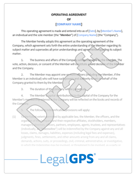Complete Guide to Data Security and Consumer Privacy: Regulations and Best Practices
 Chris Daming, J.D., LL.M. : Oct. 29, 2024
Chris Daming, J.D., LL.M. : Oct. 29, 2024
Understanding data security and consumer privacy is essential for any business that collects user information, including credit card details. This guide will help you understand the laws, restrictions, and best practices for collecting and handling sensitive data while avoiding liability.


Legal GPS Pro
Protect your business with our complete legal subscription service, designed by top startup attorneys.
- ✅ Complete Legal Toolkit
- ✅ 100+ Editable Contracts
- ✅ Affordable Legal Guidance
- ✅ Custom Legal Status Report
What Is User Data?
User data refers to personally identifiable information (PII) disclosed by users of your website. PII is information that is not publicly available and can be used to identify an individual, such as names, email addresses, telephone numbers, and social security numbers. The collection and storage of such information are regulated by federal and state laws and should be well understood by HR managers. We'll explore all this below.
Categories of User Data
User data can be classified into different categories, each requiring different handling and protection measures. These include:
-
Personally Identifiable Information (PII): Data that can be used to identify a person, such as names, addresses, and social security numbers.
-
Sensitive Personal Information (SPI): Data that requires a higher level of protection due to its nature, such as health records, financial information, or government-issued identifiers.
-
Anonymized Data: Data that has been stripped of personally identifiable elements. While this data is generally not subject to the same stringent regulations as PII, re-identification risks still exist.
-
Aggregated Data: Data that has been combined from multiple users to produce generalized information. This type of data may still be subject to privacy laws depending on its usage and potential for re-identification.
Overview of Data Security and Privacy Regulations
The primary regulatory authority for consumer privacy and data security in the United States is the Federal Trade Commission (FTC), which protects consumers from deceptive commercial practices and enforces privacy standards. In addition to federal regulations, certain states have stricter privacy laws, such as California's Online Privacy Protection Act (CalOPPA) and Massachusetts' Data Security Regulation.
Specific types of businesses, such as financial and medical institutions, are subject to additional regulations, including the Gramm-Leach-Bliley Act (GLBA) and the Health Insurance Portability and Accountability Act (HIPAA). Let's dive into some of these requirements.
Key Regulations to Know
-
Children's Data (COPPA): The Children's Online Privacy Protection Act (COPPA) applies to businesses that collect personal information from children under the age of 13. COPPA requires businesses to provide clear privacy notices and obtain verifiable parental consent before collecting such data.
Example: If your website allows children to create profiles, you must provide a privacy notice and get consent from parents before collecting any information.
-
Email Addresses (CAN-SPAM Act): If you collect email addresses for commercial purposes, the CAN-SPAM Act applies. It requires transparency in email communication, prohibits misleading subject lines, and requires a clear way for recipients to unsubscribe.
Example: Include an "unsubscribe" link in every marketing email to comply with CAN-SPAM.
-
Financial Data (GLBA): Financial institutions must comply with the Gramm-Leach-Bliley Act, which requires informing customers of information-sharing policies and providing an opt-out option. Financial institutions must also implement a written information security program to protect consumer data.
Example: Banks must notify customers of their data-sharing practices and allow them to opt-out of sharing with third parties.
-
Health Information (HIPAA): HIPAA regulates the collection and use of Protected Health Information (PHI) by health care institutions. It requires implementing safeguards to protect PHI and notifying individuals in case of a security breach.
Example: A healthcare provider must use encryption to protect patient data and notify patients if their information is compromised.
State-Level Regulations
Some states have additional requirements that go beyond federal law:
-
California Consumer Privacy Act (CCPA): Grants California residents the right to know what personal data is being collected, the right to access it, the right to request its deletion, and the right to opt-out of the sale of their data. Companies must provide detailed disclosures and honor consumer rights as specified by the CCPA. The CCPA also requires businesses to implement reasonable security procedures and practices to protect consumer data from unauthorized access.
-
California Privacy Rights Act (CPRA): An expansion of the CCPA, the CPRA adds further protections for California residents, including the establishment of the California Privacy Protection Agency (CPPA) to enforce privacy laws. It also introduces rights related to data correction, limits on data usage, and stricter guidelines for "sensitive personal information."
-
-
Massachusetts Data Security Regulation: Requires businesses to develop, implement, and maintain a comprehensive written information security program (WISP). This program must include physical, administrative, and technical safeguards, including encryption, access controls, and employee training. Businesses must also ensure that third parties handling personal information maintain similar standards of data security.
-
Key Requirements: Massachusetts requires encryption of personal information both in transit and at rest, and regular monitoring to ensure the effectiveness of the WISP. Businesses must conduct regular employee training to raise awareness about data security protocols.
-
-
New York SHIELD Act: The Stop Hacks and Improve Electronic Data Security (SHIELD) Act expands data security and breach notification requirements for businesses that collect information on New York residents. It requires businesses to implement reasonable safeguards to protect the private information of residents, including technical, physical, and administrative measures.
-
Breach Notification Requirements: Businesses must notify affected consumers and the New York Attorney General if a data breach occurs. The SHIELD Act also broadens the definition of private information to include biometric data, usernames, and passwords.
-
-
Texas Identity Theft Enforcement and Protection Act: Requires businesses to implement and maintain reasonable procedures to protect sensitive personal information and provide prompt notification to Texas residents in the event of a data breach.
-
Requirements: Businesses must notify affected individuals within a reasonable time frame, not exceeding 60 days after discovering a breach. The Act also imposes penalties for failure to comply with breach notification requirements, which can include fines of up to $100,000 per violation.
-
-
Nevada Privacy Law: Similar to the CCPA, Nevada's privacy law requires website operators to provide consumers with the ability to opt-out of the sale of their personal information. Unlike the CCPA, Nevada’s law is narrower in scope, applying primarily to businesses that sell personal data.
-
Key Requirements: Businesses must provide a designated request address where consumers can submit opt-out requests. The law mandates that businesses respond to such requests within 60 days.
-
-
Illinois Biometric Information Privacy Act (BIPA): BIPA regulates the collection, use, and storage of biometric information, such as fingerprints and facial recognition data. It requires businesses to obtain written consent from individuals before collecting biometric data and mandates specific retention and destruction policies.
-
Requirements: Businesses must inform individuals of the purpose and duration of data collection, obtain consent, and implement safeguards to protect biometric data. Failure to comply can result in substantial fines, with penalties ranging from $1,000 to $5,000 per violation.
-
Notice and Disclosure Requirements
Privacy Policies
A privacy policy is a crucial document for your website. It informs users about the types of data you collect, how you use it, and how you protect it. While the FTC does not require every website to have a privacy policy, certain states and situations do, such as when collecting data from California residents or children.
A well-crafted privacy policy helps establish trust with users and limits liability by ensuring you comply with your stated practices. If you make any changes to your privacy policy, you must inform your users and obtain their consent where required.
Privacy Notice vs. Privacy Policy
A privacy policy is an internal document that describes how your company handles customer data, while a privacy notice is provided to clients to inform them about your data practices. Financial and healthcare institutions are required to provide privacy notices to consumers at the outset of their relationship and annually thereafter.
Consent Mechanisms
Consent is a fundamental aspect of privacy compliance. There are several methods for obtaining consent from users:
-
Opt-In Consent: Requires users to explicitly agree to data collection or processing. This method is often required for collecting sensitive information or marketing purposes.
-
Opt-Out Consent: Users are informed about data collection and have the ability to opt-out if they choose. This method is less stringent and is often used for non-sensitive data.
-
Implied Consent: Assumes user consent based on their actions, such as continued use of a website after being informed about data collection practices. This method is generally not recommended for sensitive data.


Legal GPS Pro
Protect your business with our complete legal subscription service, designed by top startup attorneys.
- ✅ Complete Legal Toolkit
- ✅ 100+ Editable Contracts
- ✅ Affordable Legal Guidance
- ✅ Custom Legal Status Report
Data Security Requirements
Protecting user data is not just a regulatory requirement; it's also crucial for maintaining customer trust. There are several key steps you can take to ensure data security:
-
Encryption: Encrypt personal data both "in transit" (moving through a network) and "at rest" (stored on a server). Encryption ensures that only authorized parties can access sensitive information.
Technical Details: Modern encryption standards include AES-256 for data at rest and TLS 1.2/1.3 for data in transit. Implementing strong encryption protocols ensures data remains secure even if intercepted.
Example: A retail website should encrypt all payment information to protect against unauthorized access.
-
Access Control: Limit access to personally identifiable information to only those employees who need it. Implement safeguards such as passwords, physical security, and employee training.
Role-Based Access Control (RBAC): RBAC allows you to assign permissions based on an employee's role within the organization, ensuring that users only have access to the data necessary for their job functions. Implementing RBAC along with multi-factor authentication (MFA) significantly strengthens access control.
Example: Use RBAC to ensure that customer service representatives have access to customer records but not to financial data.
-
Regular Security Audits: Conduct regular security audits to identify vulnerabilities in your system. Regular testing and updates can prevent breaches and data leaks.
Vulnerability Scanning and Penetration Testing: Use automated tools to perform regular vulnerability scans to identify potential weaknesses in your system. In addition, hire external experts to conduct thorough penetration testing to identify and address security gaps that could be exploited by attackers. Penetration testing should be conducted at least annually or after any major system changes.
-
Data Minimization: Collect only the data that is necessary for your business operations. Limiting the amount of data you collect helps reduce risks related to storage, access, and breach.
Example: If you operate a subscription service, avoid collecting unnecessary information, such as detailed demographic data, unless you have a specific purpose for its use.
-
Data Retention Policies: Establish clear data retention policies that define how long you will keep personal data and when it will be deleted. Keeping data for longer than necessary increases the risk of breaches and liabilities.
Key Consideration: Implement automated processes for securely deleting data once it is no longer needed, and ensure that all backups are also deleted to prevent unauthorized access.
-
Incident Response Plan: Develop a data breach incident response plan that outlines the steps to take in the event of a data breach. This includes notifying affected users, investigating the breach, and mitigating its effects.
Example: Your incident response plan should include a clear escalation path for reporting the breach to senior management and legal authorities, as well as notifying affected consumers within a specified timeframe, such as 72 hours.
Breach Notification Requirements
Different jurisdictions have specific breach notification requirements that businesses must follow in the event of a data breach. Failure to comply can result in significant fines and reputational damage.
Federal Requirements
FTC Act: The FTC requires businesses to notify affected individuals if a data breach occurs due to a failure to maintain reasonable data security measures. Although the FTC Act does not have explicit breach notification requirements, the FTC may take enforcement action if a company fails to notify customers in a timely manner.
State-Specific Breach Notification Laws
-
California Breach Notification Law: Requires businesses to notify affected individuals if their unencrypted personal information is breached. Notifications must include details about the breach, the type of information compromised, and steps individuals can take to protect themselves.
Notification Methods: Notification can be provided in writing, electronically, or through substitute notice (e.g., website posting) if the cost of notifying exceeds $250,000 or the affected individuals exceed 500,000.
-
Massachusetts Data Security Regulation: Requires immediate notification to affected individuals and the Massachusetts Attorney General in the event of a breach. Businesses must also provide information on the steps being taken to address the breach and prevent future incidents.
-
New York SHIELD Act: Extends breach notification requirements to cover private information, including biometric data and online account credentials. Businesses must notify affected consumers, the New York Attorney General, and credit reporting agencies if a breach affects more than 5,000 residents.
-
Texas Identity Theft Enforcement and Protection Act: Requires businesses to notify individuals within a reasonable timeframe, but no later than 60 days after discovering a breach. Failure to comply with notification requirements may result in civil penalties of up to $100,000 per violation.
-
Illinois Personal Information Protection Act (PIPA): Requires businesses to notify Illinois residents in the event of a data breach that compromises personal information. The notice must include details about the breach, the types of information exposed, and contact information for credit reporting agencies.
Expanded Definition of Personal Information: Under PIPA, personal information includes usernames, email addresses, and passwords, in addition to traditional data such as social security numbers and financial information.
-
Florida Information Protection Act (FIPA): Requires businesses to notify affected individuals within 30 days of a data breach. If more than 500 residents are affected, the company must also notify the Florida Department of Legal Affairs.
Penalties for Non-Compliance: Fines for non-compliance can reach up to $500,000, depending on the severity and duration of the breach.
Restrictions on Using and Sharing User Information
Sharing personal information is generally allowed, but it must comply with your privacy policy and follow the principle of "fairness." In some states, like Massachusetts, you must verify that any third party receiving data can protect it with reasonable security measures.
Third-Party Data Sharing Requirements:
- Due Diligence: Perform due diligence before engaging third parties that will have access to your user data. Assess their data protection measures and request security certifications, such as SOC 2 Type II or ISO 27001.
- Data Processing Agreements (DPA): Establish DPAs with all data processors to ensure compliance with relevant regulations. The DPA should outline the scope of data usage, security measures, and responsibilities of each party.
Financial institutions are required to obtain customer consent before sharing data with unaffiliated third parties, unless certain exceptions apply. Healthcare institutions must obtain written consent before sharing PHI and ensure that third parties also protect the data.
Example: If a financial institution wants to share customer data with a marketing company, it must first notify the customer and obtain their consent.
Consequences of Non-Compliance
Non-compliance with data privacy and security regulations can result in severe penalties, including:
- Fines: Violations of CalOPPA can result in fines of up to $2,500 per incident, while violations of HIPAA can lead to fines of up to $50,000 per violation.
- Imprisonment: Criminal penalties, such as imprisonment, may be imposed for unlawful disclosure of sensitive information, especially under HIPAA.
- Brand Reputation Damage: Data breaches and non-compliance can lead to a loss of customer trust and negatively impact your brand reputation.
Example: A healthcare provider that fails to secure patient data may face fines, lawsuits, and significant reputational damage, leading to loss of patients.
Best Practices for Data Security and Consumer Privacy
- Draft a Comprehensive Privacy Policy: Ensure your privacy policy is clear, concise, and accessible to all users. Update it regularly to reflect changes in data practices.
- Encrypt Sensitive Data: Use encryption to protect data both in transit and at rest. For additional security, use asymmetric encryption for data sharing and symmetric encryption for data storage.
- Provide Data Breach Notification: If a breach occurs, notify affected individuals promptly and take steps to mitigate the damage.
- Limit Data Collection: Collect only the data you need to conduct your business. Avoid gathering excessive personal information that may increase your liability.
- Employee Training: Train your employees on data security practices to reduce the risk of data breaches. Regular training sessions ensure that everyone understands their role in protecting data.
Training Content: Focus on identifying phishing attempts, secure password practices, incident reporting, and following internal security protocols. - Secure User Access: Implement strong authentication methods, such as multi-factor authentication (MFA), to protect access to user accounts.
Example: A financial services website could use MFA to ensure only authorized users can access sensitive financial data. - Monitor Third-Party Vendors: Ensure that any third-party vendors you work with also comply with data protection standards. Include data protection requirements in contracts with vendors.
Example: If you work with a marketing firm that has access to customer data, include clauses in your contract that require them to implement data security measures. - Incident Response Drills: Conduct regular incident response drills to test your team's readiness for a potential data breach. Simulating breach scenarios helps identify gaps in your response plan and improve overall preparedness.
- Advanced Threat Detection: Implement tools like intrusion detection systems (IDS) and intrusion prevention systems (IPS) to identify and block malicious activities.
Example: Use a Security Information and Event Management (SIEM) system to collect and analyze security data from across your network for proactive threat detection.
Conclusion
Data security and consumer privacy are critical components of any business that handles personal information. By understanding the various federal and state regulations, implementing best practices for data protection, and ensuring compliance with notification requirements, you can minimize liability and build trust with your users.
Do I need a business lawyer?
The biggest question now is, "Do you need a business lawyer?” For most businesses and in most cases, you don't need a lawyer to start your business. Instead, many business owners rely on Legal GPS Pro to help with legal issues.
Legal GPS Pro is your All-In-One Legal Toolkit for Businesses. Developed by top startup attorneys, Pro gives you access to 100+ expertly crafted templates including operating agreements, NDAs, and service agreements, and an interactive platform. All designed to protect your company and set it up for lasting success.

Legal GPS Pro
Protect your business with our complete legal subscription service, designed by top startup attorneys.
- ✅ Complete Legal Toolkit
- ✅ 100+ Editable Contracts
- ✅ Affordable Legal Guidance
- ✅ Custom Legal Status Report

Legal GPS Pro: All-in-One Legal Toolkit
100+ legal templates, guides, and expert advice to protect your business.
Trusted by 1000+ businesses
Table of Contents
